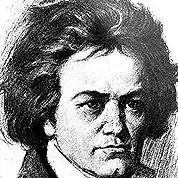Grade 1- Easy
Ode to Joy- Ludwig van Beethoven (1770-1827)
Romantic Period
 Ludwig van Beethoven was a German composer and pianist. The crucial figure in the transition between the Classical and Romantic eras in Western art music, he remains one of the most famous and influential composers of all time. |



Notes (pm)
Here’s why a pick is useless in classical guitar. It will be impossible for the right hand to play 2 or more strings with a pick when the notes are at extreme ends say (High E and Low e). You can accomplish this easily if you lose the pick and free your fingers.
By using your pulgar or thumb(p) and middle(m). You can strike 2 notes at the same time. Take this song slow and make sure you nail the 2 notes simultaneously. Take heed of the back beat note (G) G open string which you play with your index. This piece is in the key of C. Why is the G note so prominent? I know little about music but i can tell you G is in the C chord. What is a C chord? let’s see. C, E and-you guess it-G. The thumb or pulgar (spanish) is responsible for the playing the 3 bass strings (4,5,6) DAE most of the time. The other fingers usually play the treble strings (1,2,3) eBG.

Pingback: Ode to Joy (chords) by Ludwig van Beethoven on classical guitar including free sheet music, pdf, midi, guitar pro, gpx, tablature, tab and some playing tips | Class Clef